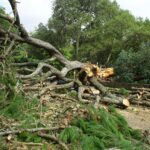At a glance:
- Low-hanging branches obstruct walkways and driveways, making it difficult for people to get around in their yards without being hit by a branch.
- In some cases, tree pruning may be enough to remove the low-hanging branches and promote healthy growth.
- Look for “affordable tree service near me” to find the best providers in your area.
Tree branches can be a nuisance, not to mention the numerous dangers they pose.
Suppose you have low-hanging branches on your property. In that case, it’s essential to take them seriously and address the issue before it becomes a safety hazard or causes damage to your property.
This article will explore how to handle low-hanging tree branches on your property.
Why Remove Low-Hanging Tree Branches?
A tree is a towering, majestic thing symbolising the earth and its bounty. If a tree can do that much for the world, it would be able to raise its branches. But sometimes trees have trouble with that, especially when tall and old. That’s when they need help raising their crowns or removing their lower branches.
- Low-hanging tree branches can be inconvenient, causing safety hazards and damaging your property or that of your neighbours.
- Low-hanging branches obstruct walkways and driveways, making it difficult for people to get around in their yards without being hit by a branch.
- They make it difficult to mow your lawn, leading to uneven grass growth. They necessitate frequent mowing and watering of your property to look presentable—which adds to high costs over time.
- Low-hanging branches can damage your property or that of your neighbours during high winds and storms, especially if attached to an old or weak tree that could fall over at any moment.
Pruning vs. Removal
Tree pruning may be needed for many reasons: to control the tree’s size or shape, to improve its health, or to rejuvenate it. But if you’re looking at a dead or dying tree, it’s time for removal. Once hired, a professional arborist will assess your tree and determine whether pruning or tree removal is necessary. In some cases, tree pruning may be enough to remove the low-hanging branches and promote healthy growth. Removal may be required if the branches are too large. Your arborist will determine the best course of action.
Handling Low-Hanging Branches on Your Property
You’re ready to start pruning your trees and shrubs, but where do you begin?
You can save a lot of time and money by identifying low-hanging branches on your property before you hire a tree pruning service. The first step is to walk around your yard and look for branches blocking your view or hanging over power lines. Make a list of branches that need to be pruned or removed.
Trimming any branch lower than your head is a good rule of thumb. If you have kids or pets, you’ll want to keep them off the ground as much as possible so they don’t get hurt on fallen branches.
Determine the Best Time to Prune
Low-hanging branches are a common annoyance for homeowners, but they can be easily removed. The best time to prune them is in late winter or early spring when there are no leaves on the tree. It will give you an unobstructed view of the branch and make it easier to identify its origin.
If you wait until the weather is warm, there is a risk that the leaves will obscure your view and make it hard to see what might be causing problems with the tree. It could lead to unnecessary pruning that could cause more harm than good.
Assess the Branches
When pruning your trees, keep a few things in mind. You should never trim branches from the bottom up. Instead, start with the branches closest to the trunk and work your way down. It is because the weight of the branch can cause damage to the trunk.
Next, take a moment to assess each branch and determine how high you should cut it off from the trunk (usually about two inches above ground level). You should also look for side shoots or sprouts that could grow into another branch if left alone. You should also remove them because they will eventually become thick enough to cause damage like those described above if left unchecked!
Pruning the Branches for a Healthier Tree
Pruning is the best option if branches are not posing a safety risk. Pruning involves cutting back the branches to a healthy and safe length, which promotes the tree’s health and prevents future safety risks. When pruning, it’s essential to make a clean cut just outside the branch collar with sharp and clean pruning shears.
If you need to decide whether your tree needs to be pruned, talk to your local arborist about your options. They can advise you on protecting your trees without having them removed from your property altogether.
Removing Low-Hanging Branches for Safety
If you have low-hanging branches that pose a safety risk or are too large to prune, they must be removed. However, this is a dangerous job and should be done by a professional arborist.
Low-hanging branches can be dangerous because they’re close to the ground and often difficult to see from above. If one of these branches falls on you or someone else in your home, it can cause serious injury (or worse). You could risk your property and life if you don’t do the job correctly.
Search online for “tree pruning near me” to find affordable tree service providers in your area.
Proper Disposal of Low-Hanging Branches
After pruning or removing the branches, it’s essential to dispose of them properly. You can use the branches for firewood, mulch, or compost. If you don’t have a use for them, contact your local waste management company for disposal options.
The best way to dispose of branches is by using them as mulch or compost.
Mulch helps retain water in the soil around plants and can help prevent weeds from growing. Compost allows you to reuse the nutrients from the branches in your garden next season.
Safety First
If you’re considering pruning or removing low-hanging tree branches, ensuring the job is done safely and without incident is essential.
Look for “affordable tree service near me” to find the best providers in your area. Ensure your chosen service provider is licensed, insured, and experienced to handle the job safely.
A professional arborist will have the necessary safety equipment and training to ensure the job is done safely. Still, they also take precautions to protect your property and any nearby structures.
It’s important to remember that hiring an arborist means you won’t need to worry about any potential accidents or injury from falling limbs or debris.
Things to keep in mind while handling low-hanging tree branching on your property
You can’t just cut a tree branch off!
- When you’re working with trees, you need to make three cuts. The first cut is on the underside of the branch, about 2-3 feet away from the trunk. It prevents it from splitting and harming your precious plant.
- Next, cut through the branch a foot or less outside the notch cut, allowing most of its weight to fall safely away. Finally, make your final cut right at the branch collar (where it joins the tree).
- You don’t want to go past this because it will prevent it from healing correctly—and no one wants an ugly scar! Nor do you want to leave too big a stump because that could cause future problems for your lovely tree.
Like a scab on a human or animal, this protective covering will form over time and protect your removed limb forever.
Why hire a professional arborist to handle low-hanging tree branches?
The most significant advantage of using a professional arborist is their expertise. They have years of experience working with trees and can tell you how much weight each branch might carry.
They’ll also know how to cut the branches so they don’t snap back and injure anyone nearby or damage anything else on your property.
When you hire an arborist to do this work for you, it’s essential to ensure their state or municipality licenses them.
It means they’ve passed rigorous tests before being allowed to work on trees in public areas, including parks and other spaces where people might be at any time during their training!
Ensure they are insured if anything goes wrong during removal; this will cover any accident-related expenses. For example, broken windows or damaged fences will be covered by insurance in the case of falling branches during the removal process.”
Conclusion
If you have low-hanging tree branches on your property, there are steps you can take to address the issue. Identify the branches that need to be pruned or removed, and take action to ensure the safety and health of your tree. If you need assistance, don’t hesitate to contact a professional arborist for tree pruning near me, tree branch removal, and affordable tree service.





